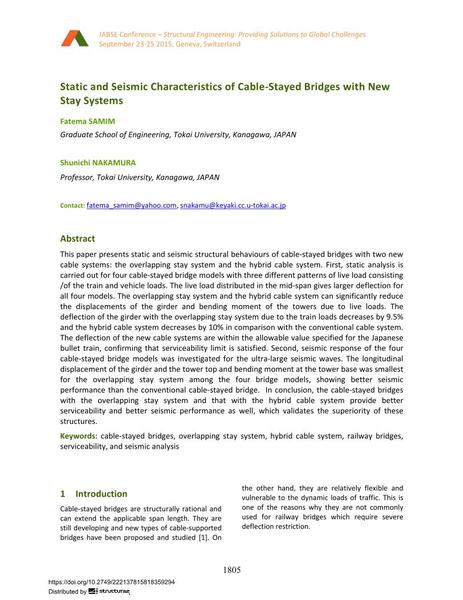Static and Seismic Characteristics of Cable-Stayed Bridges with New Stay Systems

|
|
|||||||||||
Bibliographic Details
| Author(s): |
Fatema Samim
(Graduate School of Engineering, Tokai University, Kanagawa, JAPAN)
Shunichi Nakamura (Professor, Tokai University, Kanagawa, JAPAN) |
||||
|---|---|---|---|---|---|
| Medium: | conference paper | ||||
| Language(s): | English | ||||
| Conference: | IABSE Conference: Structural Engineering: Providing Solutions to Global Challenges, Geneva, Switzerland, September 2015 | ||||
| Published in: | IABSE Conference Geneva 2015 | ||||
|
|||||
| Page(s): | 1805-1812 | ||||
| Total no. of pages: | 8 | ||||
| Year: | 2015 | ||||
| DOI: | 10.2749/222137815818359294 | ||||
| Abstract: |
This paper presents static and seismic structural behaviours of cable-stayed bridges with two new cable systems: the overlapping stay system and the hybrid cable system. First, static analysis is carried out for four cable-stayed bridge models with three different patterns of live load consisting /of the train and vehicle loads. The live load distributed in the mid-span gives larger deflection for all four models. The overlapping stay system and the hybrid cable system can significantly reduce the displacements of the girder and bending moment of the towers due to live loads. The deflection of the girder with the overlapping stay system due to the train loads decreases by 9.5% and the hybrid cable system decreases by 10% in comparison with the conventional cable system. The deflection of the new cable systems are within the allowable value specified for the Japanese bullet train, confirming that serviceability limit is satisfied. Second, seismic response of the four cable-stayed bridge models was investigated for the ultra-large seismic waves. The longitudinal displacement of the girder and the tower top and bending moment at the tower base was smallest for the overlapping stay system among the four bridge models, showing better seismic performance than the conventional cable-stayed bridge. In conclusion, the cable-stayed bridges with the overlapping stay system and that with the hybrid cable system provide better serviceability and better seismic performance as well, which validates the superiority of these structures. |
||||
| Keywords: |
cable-stayed bridges railroad bridges rail bridges serviceability overlapping stay system hybrid cable system seismic analysis
|
||||

